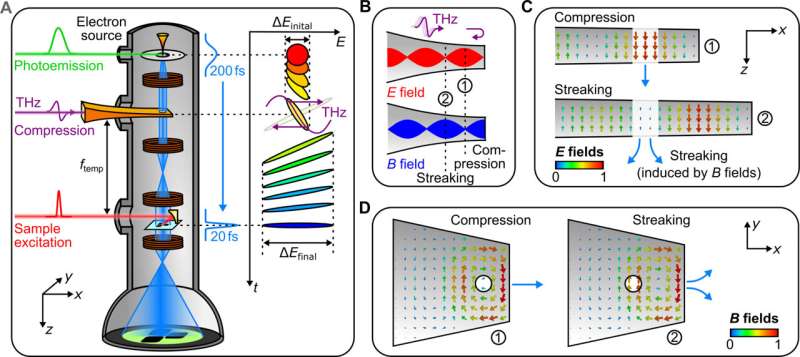This article has been reviewed according to Science X's editorial process and policies. Editors have highlighted the following attributes while ensuring the content's credibility:
fact-checked
peer-reviewed publication
trusted source
proofread
Time-compression in electron microscopy: Terahertz light controls and characterizes electrons in space and time

Scientists at the University of Konstanz in Germany have advanced ultrafast electron microscopy to unprecedented time resolution. Reporting in Science Advances, the research team presents a method for the all-optical control, compression, and characterization of electron pulses within a transmission electron microscope using terahertz light. Additionally, the researchers have discovered substantial anti-correlations in the time domain for two-electron and three-electron states, providing deeper insight into the quantum physics of free electrons.
Background and challenges
Ultrafast electron microscopy is a cutting-edge technique that combines the spatial resolution of traditional electron microscopy with the temporal resolution of ultrafast femtosecond laser pulses. This powerful combination allows researchers to observe atoms and electrons in motion, capturing dynamic processes in materials with unparalleled clarity. By visualizing these rapid events in space and time, scientists can gain deeper insights into the fundamental mechanisms that govern material properties and transitions, helping to create advancements in research fields such as nanotechnology, optics, materials science, and quantum physics.
Although ultrafast electron microscopy enables, in principle, the observation of atomic and electronic motions on fundamental spatial and temporal scales, capturing these rapid dynamics has remained challenging due to the limitations in electron pulse duration. The current standard electron pulses, lasting about 200 femtoseconds, are too long to resolve many fundamental reaction processes in materials and molecules. Pulses ten times shorter would be required to observe basic reaction paths and collective atomic motions, so-called phonon modes, in real time.
Generation of ultrashort electron pulses
Now, the Konstanz team has introduced a groundbreaking approach to advance the time resolution of transmission electron microscopy from hundreds to tens of femtoseconds. The researchers utilize a single optical cycle of terahertz light to manipulate the electron pulses in space and time on the dimensions of single-cycle laser light. This method not only preserves the spatial resolution of the electron microscope but also enhances its temporal resolution to the regime of visualizing atomic and potentially even electronic motions on fundamental scales.
"One of the primary challenges in ultrafast electron microscopy is the unavoidable energy bandwidth of ultrafast photoemission from a laser-triggered needle tip. Due to the dispersion of vacuum for non-relativistic electrons with rest mass, this energy bandwidth unavoidably leads to quantum-mechanical wave packet dispersion and pulse lengthening in time," explains Peter Baum, head of the Light and Matter Group at the University of Konstanz.
The team overcame this problem by utilizing the electric field gradient of terahertz pulses to accelerate the trailing part and decelerate the leading part of the electron wave function, resulting in significantly compressed pulses in the specimen. Due to the limited available space inside of the microscope, the team achieved this control by employing a metallic parallel-plate waveguide to generate the necessary sub-cycle field-electron interactions at sufficient spatial homogeneity and minimized aberrations.
"A key aspect of our approach lies in the special electric and magnetic fields generated within the waveguide. By designing a waveguide that creates a standing terahertz wave with precise phase control, we can amplify electric fields while canceling out unwanted magnetic fields. This configuration allows for the acceleration and deceleration of electron pulses without introducing spatial aberrations," summarizes Joel Kuttruff, the Ph.D. student who designed the experiment.
Using this idea, the team has successfully compressed their electron pulses from over 200 femtoseconds to just 19 femtoseconds. This advance promotes the time resolution of electron microscopy into the domain of fundamental atomic dynamics and reaction paths.
"Even at the enhanced temporal resolution, the spatial resolution of the microscope remains almost uncompromised" says Baum. In the experiments, microscope images and diffraction patterns of gold nanoparticles and silicon crystals demonstrate these clear and precise imaging capabilities at, now, an unprecedented resolution in the time domain.
Correlations in multi-electron states
In a first application of their novel capabilities, the researchers have measured two-electron and three-electron states and have discovered substantial anti-correlations in the time domain, providing deeper insight into the interactions and dynamics of multi-electron systems.
"When one electron arrives early, the other arrives late, and vice versa, creating a clear temporal separation between the two," explains David Nabben, postdoctoral researcher on the team. "This anti-correlation is a result of mutual Coulomb forces and wavepacket dispersion during free-space propagation."
The ability to measure double-electrons or triple-electrons and their correlations in the time domain is critical for advancing our understanding of quantum mechanics in the domain of fluctuations and noise.
"By precisely controlling and observing free-electrons and their mutual interactions, we lay ground for future research aiming at investigating fundamental quantum phenomena, such as electron pairing and entanglement, with unprecedented detail," says Baum, describing the impact of this work. "This capability together with our novel regime of time resolution will potentially lead to new quantum technologies and enhance our knowledge of material behaviors at the atomic scale."
More information: Joel Kuttruff et al, Terahertz control and timing correlations in a transmission electron microscope, Science Advances (2024). DOI: 10.1126/sciadv.adl6543
Journal information: Science Advances
Provided by University of Konstanz



















